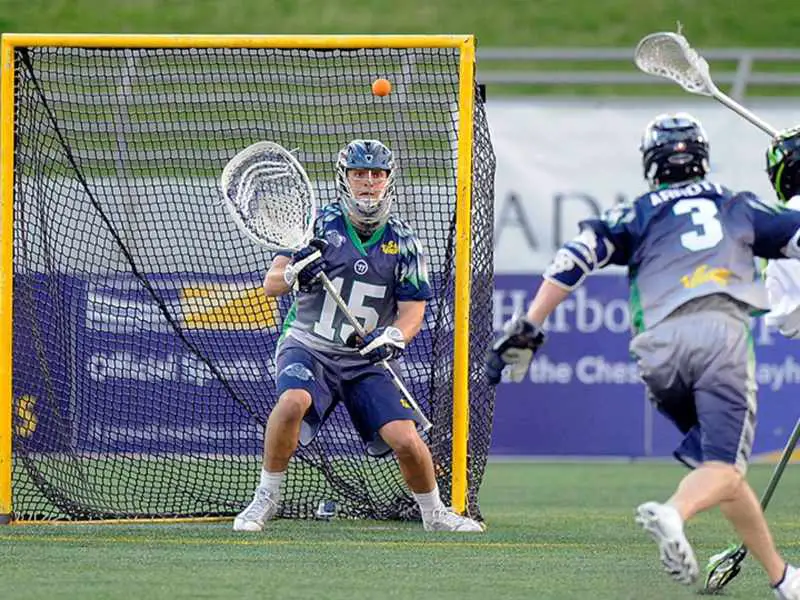In sports like lacrosse where players use a stick to play, there could often be confusion about whether they could use their hands to touch the ball. Does the rule say lacrosse players cannot touch the ball with their hands under any circumstances or is there an exception to the rule? This post clears out the confusion and answers the question, can you hand touch the lacrosse ball during a game.
According to the rules, lacrosse players aren’t allowed to touch the ball with their hands. Legal contact with the ball has to be done using the lacrosse stick. However, this rule excludes goalies. Lacrosse goalies are the only players on the field who can use their hands on the crease to block shots.
To understand why this rule makes perfect sense, we want to examine lacrosse through the lens of regulators and lacrosse players. Additionally, we would use this opportunity to highlight the subtle differences between field players and goalies governed by rules.
The nature of lacrosse: using your stick to play
The name “lacrosse” came from French, “La Crosse” which means stick. It speaks to the fact that lacrosse, as a sport, relies on the use of a stick to perform every action. Players use their sticks to shoot, pass and regain possession. Unlike other sports that use direct contact with the balls, the lacrosse stick act as an extension of the player’s hand to control the ball. In other words, players aren’t allowed to use their hands to touch the ball during a game.

Due to this unique nature of the game, lacrosse sticks resemble many attributes of a hand to keep ball retention. Every stick is made of two parts: the shaft and the head. The shaft is like your arm and in lacrosse, the shaft is where you put your hands for gripping. The head is like your hand and the pocket is the equivalent of the palm of your hand.
After you catch a ball, it naturally sits inside the pocket which mimics the concept of you holding a ball inside the palm of your hand. This design is intentional in order to give the player just enough ball-handling ability so that the opponent also has an opportunity to knock the ball loose.
But..there’s one exception: the goalies
Goalies have a tough job. They are the last line of defense between a save and a score, so as you can imagine, the pressure is immense. Luckily, goalies have more freedom and privileges than other field players. Specifically, they are allowed to use their hands to block and make a save to prevent the ball from going into the net. However, if the ball is on the ground within the crease, the goalie cannot touch or throw the ball with their hands. In other words, goalies have the permission to bat the ball away only when it’s in the air.
For your reference, this is the exact wording taken from the NCAA men’s lacrosse rulebook.
“The goalkeeper, in his own crease area, may stop or block the ball in any manner with his crosse or body. The goalkeeper may block the ball or bat it away with his hand, but he may not catch the ball with his hand. However, if the ball is outside the crease, the goalkeeper may not touch it with his hand even if he is within his crease. (See Rule 6-6-a.) The goalkeeper or any other player of the defending team may receive a pass while in the crease area.” (Source)

Some nuances worth highlighting are the following:
- This rule lies under the section called “goal-crease privileges” which means as a goalie, to exercise this privilege, you must be positioned on the crease
- Notice the rule doesn’t extend the right for a goalie to pick up or hold the ball even on the crease
As a goalie, you would want to learn the ins and outs of the rules to avoid drawing any fouls. Although all players can draw fouls, goalies committing a foul will most likely result in the other team scoring a free goal. Thus, it’s crucial you are familiar with the rules very well.
Why are players not allowed to use their hands
To understand why this rule makes sense, we want to look at it in the spirit of regulators and lacrosse players. In my opinion, there are two major reasons.
Using hands will give offensive players an unfair advantage
Who wins possession wins the game. This goes to show you how challenging it is already for defensive players to disrupt offensive play and regain possession. Under current rules, they have to deliver an accurate and forceful check on the opponent’s shaft to stand a chance. Plus, good body shielding and dodging techniques already put offensive players in a better position to keep ball retention.
Allowing hand contact with the ball will only put defensive players officially at a disadvantage. It would be nearly impossible to even attempt at knocking the ball out of the pocket. Because offensive players could just cover the pocket using their hands and prevent the ball from falling out from stick checks. Essentially allowing hand contact will severely damage the balance between offense and defense of the game.
Hand contact goes against the spirit of the game
Lacrosse is unique because of the way it’s played. It’s exciting also because of the way it’s played. Every part of the game is built upon this foundation, which is players use their sticks to play.
When beginners signed up for this sport, they were drawn to the idea of utilizing this piece of equipment to compete. Every day they play wall ball to develop a natural feel for the lacrosse stick in order to eventually be able to wield its power as if you are using your hand.
And this is the spirit of lacrosse. This is where blood, sweat and tears happen behind the scene. If rules allow hand touching, it will fundamentally discredit this very nature of lacrosse.

Conclusion
It’s probably not a surprise for most players that they cannot touch the ball during a game, but many probably didn’t realize the exception for goalies. In fact, I had my fair share of doubts as well. So I went to the NCAA rulebook to check it for myself.
The act of a goalie using their hands to make a save is indeed a rare occurrence. It’s possible that you won’t see that ever happen in your career. 99% of the time, goalies will try to block and make a save using their goalie sticks or body parts. So in my opinion, what this exception tries to accomplish is to give goalies some leeway without overbearing them with a potential foul.
I hope this is post has cleared your confusion and learned different rules apply to different positions. For field players just simply remember under no circumstances, are you allowed to use your hand to make contact with the ball. For goalies, you can use your hand to bat down the ball but not pick it up or hold it.
Read also: How to improve off-hand in lacrosse





